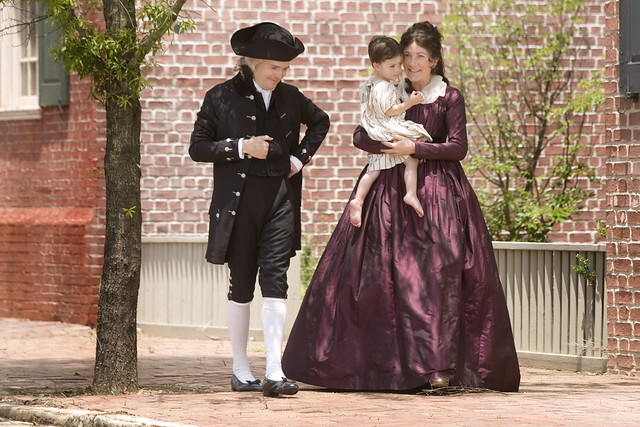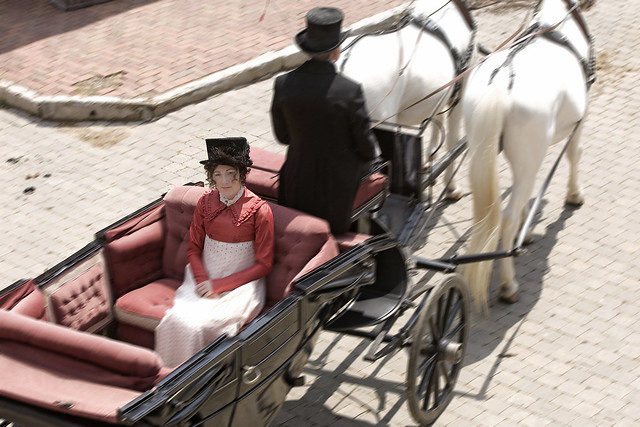Portrait of Dolley Madison by Alan Dordick, after Gilbert Stuart
Courtesy of the Montpelier Foundation & Alan Dordick Studios
Today marks the 243rd anniversary of Dolley Payne Madison’s birth! "Mrs. Madison" will be celebrating at Montpelier today where guests can join her for some birthday cake and lemonade! Montpelier is also offering free admission to any visitors born on this date or to those who share Dolley's first name. (You can find more details about the celebration on Montpelier's facebook page or website.)Mr. and Mrs. Madison celebrating Mr. Madison's birthday earlier this year at Montpelier.
Montpelier, the long-time Madison family home in Virginia, is hosting an exhibit dedicated to Mrs. Madison and her trend-setting fashion. "Dolley Madison's Life Through Fashion: Dressing the Part" will be open at Montpelier June 15, 2011 through March 31, 2012. The exhibit will feature costumes from the recent PBS documentary, “Dolley Madison, America’s First Lady,” and will explore the fashions and styles favored by America’s “first” First Lady. Inspirational fashion plates and designer sketches for the costumes will also be on display.
A sketch of Dolley's "Quaker Dress" from the documentary
“Dolley Madison, America’s First Lady."
“Dolley Madison, America’s First Lady."
Photo courtesy of the PBS American Experience Flickr page.
The costumes were designed by Candice Donnelly and constructed by Eric Winterling, Inc. in NYC. Constructing clothing for period accuracy and designing "costumes" for film require some of the same general concepts, but they generally have two very different purposes in terms of the final product. In this behind the scenes feature, Ms. Donnelly describes the process of creating historic costumes for film. She studied period prints and paintings which, she explains, not only helped her to choose fabrics, but also gave hints as to how the garments were constructed. Since the documentary spanned a time period of approximately fifty years, the costumes needed to reflect the changing fashions of the time as well as the continuous evolution of Dolley's situation in life. The video also shows Eve Best (Dolley Madison) during her costume fittings with Eric Winterling, which allows you to catch a closer look at some of these beautiful creations. What I found most interesting in this feature was Ms. Donnelly's description of how the costumes are incorporated into the film and characters. Costume designers have to think about the personality and the history of the person who will be wearing them. They also have to consider the sets and backgrounds, as well as any furniture, props, or other characters in any given scene. Accessories, she explains, can be used to accentuate the costumes and to keep the character from blending into the background of the shot.
Eve Best as Dolley Madison in “Dolley Madison, America’s First Lady."
Photo courtesy of the PBS American Experience Flickr page.
Fashion was changing quickly at the turn of the century and Dolley was sure to keep up with the latest styles. As the frequent hostess for President Jefferson and then as First Lady, Mrs. Madison was a model to others who admired her and closely followed her trends. One of her favorite new accessories was the turban. Edward Maeder, fashion historian and milliner for the documentary, explains a brief history of the turban revival and demonstrates how he constructed the turbans used in the film in this behind-the-scenes video.
The documentary, which is part of the PBS series American Experience, premiered earlier this year. You can view the show and read the transcript on the companion website. The website also offers a host of special features and resources, from behind the scenes videos and deleted scenes to a reading list and lesson plans for teachers.
An example of Dolley wearing a turban in this portrait by Joseph Wood.
The Virginia Historical Society, Accession No. 1967.14
The documentary, which is part of the PBS series American Experience, premiered earlier this year. You can view the show and read the transcript on the companion website. The website also offers a host of special features and resources, from behind the scenes videos and deleted scenes to a reading list and lesson plans for teachers.
Jefferson Mays as James Madison and Eve Best as Dolley Madison
in “Dolley Madison, America’s First Lady."
in “Dolley Madison, America’s First Lady."
Photo courtesy of the PBS American Experience Flickr page.
Dolley Payne was born in North Carolina in 1768 and moved with her family to Virginia the next year. When Dolley was 15 years old, her father followed the trend of his fellow Quakers: he emancipated his slaves and moved the family to Philadelphia where he attempted to start a starch-manufacturing business. By 1789, Mr. Payne's business was a failure and he was shunned from Quaker meetings due to outstanding debts. Mrs. Payne fortunately had more business sense, and she set about establishing a successful boarding house in town, which continued to support the family following Mr. Payne's death in 1792. In 1790 Dolley married John Todd, a Quaker man her father had chosen. Two years later, the couple welcomed their first son, John Payne. The year 1793 brought an epidemic of Yellow Fever, during which Dolley lost several family members including both her husband and their second son, William Temple, who was only a month old at the time.
She met James Madison the next year through their mutual friend, Aaron Burr. Madison asked Burr to introduce them, and after a short courtship, Madison proposed. At age 43, seventeen years Dolley's senior, Madison had never been married and was thought by many to be a lifetime bachelor. They were married within the year and Dolley was subsequently dismissed from the Quaker community for marrying outside the group. A few years later, they moved to Madison's home, Montpelier, only to move to the new capitol of Washington D.C. in 1801 following Madison's appointment as Secretary of State.
She met James Madison the next year through their mutual friend, Aaron Burr. Madison asked Burr to introduce them, and after a short courtship, Madison proposed. At age 43, seventeen years Dolley's senior, Madison had never been married and was thought by many to be a lifetime bachelor. They were married within the year and Dolley was subsequently dismissed from the Quaker community for marrying outside the group. A few years later, they moved to Madison's home, Montpelier, only to move to the new capitol of Washington D.C. in 1801 following Madison's appointment as Secretary of State.
One of Mrs. Madison's own gowns on display in
"The First Ladies at the Smithsonian" exhibit at the National Museum of American History.
The caption for the gown reads: "Dolley Madison’s silk satin
open robe is hand-embroidered with flowers, butterflies, dragonflies,
and phoenixes. It is typical of the style of the late 1810s."
"The First Ladies at the Smithsonian" exhibit at the National Museum of American History.
The caption for the gown reads: "Dolley Madison’s silk satin
open robe is hand-embroidered with flowers, butterflies, dragonflies,
and phoenixes. It is typical of the style of the late 1810s."
During the couple's first years in the Capitol, Dolley took an active role in supporting the nation's new government. Her natural ability to make guests at ease made her the perfect candidate to aid President Jefferson as White House hostess. When Madison was elected President in 1809, Dolley began setting the precedent for political wives and First Ladies. She set about decorating the White House in a style that was elegant yet not monarchical. Her own clothing fashions mirrored these ideas and others began to mimic her trends. But Dolley was always first and foremost her husband's strongest supporter in both political and personal matters.
Eve Best as Dolley Madison in “Dolley Madison, America’s First Lady."
Photo courtesy of the PBS American Experience Flickr page.
After two terms as President, leading through the War of 1812, Madison and his wife finally retired back to their home at Montpelier, where they would remain happily for the next several years. Their 41 year marriage ended in June 1836 when James Madison passed away. Today we have a limited glimpse into the Madison's marriage due to the lack of correspondence between the two; they were so rarely apart so that there was never a need for letter writing! Following her husband's death, Dolley spent the majority of her time in Washington D.C. Her only son, John Payne Todd, continuously caused distress with his constant gambling habits and he was unable successfully to manage the Madison estate. In 1844, Dolley was forced to sell Montpelier. Mrs. Madison passed away on July 12, 1849 at the age of 81. Unfortunately, since Montpelier was then in private hands outside of her family, she was initially buried in Washington D.C., before finally being brought to rest next to her husband.
For more about Dolley Madison, read her biography on the Montpelier website and visit some of the links below.
For more about Dolley Madison, read her biography on the Montpelier website and visit some of the links below.
Additional Links and Resources:
Miniature of Mrs. James Madison (artist unknown)
Yale University Art Gallery eCatalogue
Collection 1940.512
Image of 1804 portrait of Dolley Payne Madison by Gilbert Stuart
Yale University Art Gallery eCatalogue
Collection 1940.512
Image of 1804 portrait of Dolley Payne Madison by Gilbert Stuart
The White House Historical Association (White House Collection)
Acquisition Number: 994.1737.1
Image of 1817 portrait of Dolley Madison by Bass Otis
Collection of The New-York Historical Society
Object Number: 1867.308
Image of 1848 portrait of Dolley Madison by William S. Elwell
National Portrait Gallery, Smithsonian Museum
Ref: NPG.74.6
Image of 1817 portrait of Dolley Madison by Bass Otis
Collection of The New-York Historical Society
Object Number: 1867.308
Image of 1848 portrait of Dolley Madison by William S. Elwell
National Portrait Gallery, Smithsonian Museum
Ref: NPG.74.6
Free iTunes Download of Poplar Forest Conversations on Democracy
featuring Lauren Leigh as Dolley Madison and Bill Barker as Thomas Jefferson









I always learn such a lot from these posts.
ReplyDeleteThanks, Jan. I really enjoyed learning more about Dolley and the Madison family as well. I hope to get down to Montpelier at some point to visit their home and to see the new exhibit!
ReplyDeleteWhat a great post! Thanks for writing about the exhibition at Montpelier - I hope I can see it.
ReplyDeleteThanks for a GREAT POST!
ReplyDeleteI ordered a Dolley Biography and the PBS DVD the other day from Amazon and now I am even MORE anxious for them to arrive!!
Great job Blessings, Linnie
Oh we have to go back to see the exhibit! Thanks for telling us! The kids and I went with friends for Mrs. Madison's birthday 2 years ago. Our friends invited us to go down with them and to wear costumes like them. Although my daughter has a Regency gown, the kids all went colonial. I have the best pictures of them playing on the grounds on my blog. I think I have a Montpelier link.
ReplyDeleteLaurie
I'm glad you all enjoyed the post!
ReplyDeleteLaurie: Thanks, I went back and read your posts about Montpelier. Such neat pictures of frolicking in costumes! I enjoyed your pictures and post about the restoration, too. And how interesting to find out that the statue is life sized!